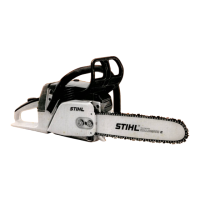20
-
21
If the tree has large
buttress roots, cut into the
largest but-
tress vertically first
(horizontally
next) and remove the
re-
sulting
piece
(ill. 20).
Two
felling techniques are recommended,
the conventio-
nal cut and the open-face
cut.
With either
technique the
first
step
is
to
determine the placement of
the felling notch
on
the side of the tree in the
planned direction of the fall
(ill. 21). When properly placed the felling notch determines
the direction
in which the
tree
will fall. It is made perpendi-
18
cular to the line
of fall and should be close to the ground.
Hinge
Felling
notch
22
Felling
cut
With the
conventional cut begin with the top cut of the
felling
notch, and cut down at
approximately a 45-degree
angle to a depth of about 1/5 to
1/4
of the trunk diameter.
Make the second or lower cut horizontal until it meets the
first
cut.
Remove
the
resulting
45-degree piece (ill. 22).
With the
open-face
technique, the object is to make a
90-degree notch in the
tree
trunk
to a
depth
of approxima-
tely
1/5
to
1/4
of the
tree's diameter.
Beginning with the top
cut of the notch, cut down at approximately a 50-degree
angle to a depth of approximately 1/5 to
1/4
of the dia-
meter of the tree. Make a second cut from below also at
approximately
a
40-degree
angle. Remove
the resulting
90-degree open-face piece (ill. 23).
With both techniques, the felling notch
should be made
very
carefully. When making the second
cuts,
look through
the previously made kerf
to
insure
that to two
cuts meet
properly.
Once
the
felling notch has been completed,
you are ready
to
begin the felling cut on
the opposite side of the
tree.
With the conventional and open
face notch, begin
the

